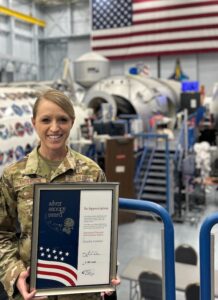
Story by Maristela Romero
Air Force Medical Service
Behind the scenes of every spaceflight are hundreds of individuals at NASA who ensure the safety and success of its astronauts from start to finish.
One of those individuals is U.S. Air Force Lt. Col. Danielle Anderson, the USAF’s first physical therapist stationed at NASA to earn the Silver Snoopy Award for her work providing a range of clinical care to astronauts while supporting research on optimizing human performance during and post-spaceflight.
Less than one percent of the aerospace workforce earn a Silver Snoopy Award, an honor that begins with a nomination from an astronaut who acknowledges an individual’s significant contributions to the human space flight program. U.S. Navy Capt. Josh Cassada, a physicist who has been with NASA since 2013, nominated Anderson.
During a ceremony, NASA presented Anderson with a sterling silver Snoopy lapel pin that astronauts had flown into space, and gave her a certificate of appreciation and commendation letter signed by Cassada.
For Anderson, receiving a Silver Snoopy extends far beyond personal achievement.
“It symbolizes the pivotal role of physical therapy in supporting a high-performance organization like NASA in its unique mission to explore space,” she said, reflecting on her daily responsibilities that encompass a spectrum of tasks ranging from injury prevention to rehabilitation in support of the whole course of a spaceflight.
Anderson has led the Space Medicine Operations Musculoskeletal Medicine and Rehabilitation team at NASA’s Johnson Space Center in Houston, Texas, since September 2021.
As an Air Force physical therapist embedded in NASA, she views her role as a liaison between the flight surgeons – the primary care providers for astronauts – and the Astronaut Strength, Conditioning, Rehabilitation Group. Ultimately, she oversees the care needed to optimize each astronaut’s condition while collaborating with this interdisciplinary team.
Anderson emphasized the prevalence of musculoskeletal injuries across all operational environments and the need for frequent evaluations as a common preventive measure.
“There are these low-level kind of nagging, irritating conditions that limit performance to the highest level of capability. Our skill set as physical therapists is that we have a wide range of scope to enhance performance without any need for higher levels of intervention,” she said.
Prior to NASA, her medical career began as a doctoral graduate from Regis University in 2012. Within the same year, she joined the Air Force and was first stationed at Travis Air Force Base, California, as a physical therapist where she deployed to Afghanistan and Bahrain to support Operation Enduring Freedom.
With more than 12 years of service in the Air Force, Anderson has established herself as a seasoned expert in her field. A testament to her performance, she earned the 2021 Air Force Medical Service Award for Biomedical Clinician of the Year as a field grade officer. To improve her knowledge, she continually seeks training in space medicine while working to safeguard the health of astronauts in preparation for the extreme conditions of space.
Anderson supports NASA while mission team members are on Earth and in space. The Silver Snoopy Award recognizes her work with the members of NASA Expedition 68, including Cassada, who spent five months aboard the International Space Station from 2022 to 2023. She helped the astronauts before and during the mission by optimizing their health and safety for a zero-gravity environment, then acclimated them to Earth upon their return.
“The most taxing physiological training that we do is getting ready for spacewalks. We go outside of the space station to repair or upgrade the hardware out there,” said Cassada, recalling three spacewalks he participated in during the expedition, each lasting about seven hours in space.
“We are so grateful that she’s here and that the Air Force is in a spot to put her here,” he said. “It’s really hard to imagine what we were doing before Danielle. She’s an incredible asset to what we do and to getting the job done.”
Through Anderson’s own extensive research and operational experience of the physiological effects of microgravity on the human body, she provided an evidence-based regimen of exercises in preparation for the launch and to maintain the astronauts’ health for the long-duration spaceflight.
“When I’m on board the space station, we’re continuing to make sure that we’re staying healthy,” said Cassada. “The remote support is something we must be good at here at NASA. And Danielle absolutely crushes it whether we are on the planet or off it.”
Cassada emphasized that the consistent feedback and encouragement that Anderson provided his crew received was vital to their confidence in succeeding with their mission.
“This is coming from the entire astronaut office – she’s the kind of person we want to fly with in space. And in fact, we feel like we did,” said Cassada. “She was as critical as any crew member could be.”
Anderson continues to set a foundational level of understanding at NASA for the effects of space on human physiological health while bringing the Air Force’s mission of preparedness to the table.
“I do envision that our role continues here in the long-term,” Anderson said. “And that we can consistently send physical therapists to this location to support awesome missions.”